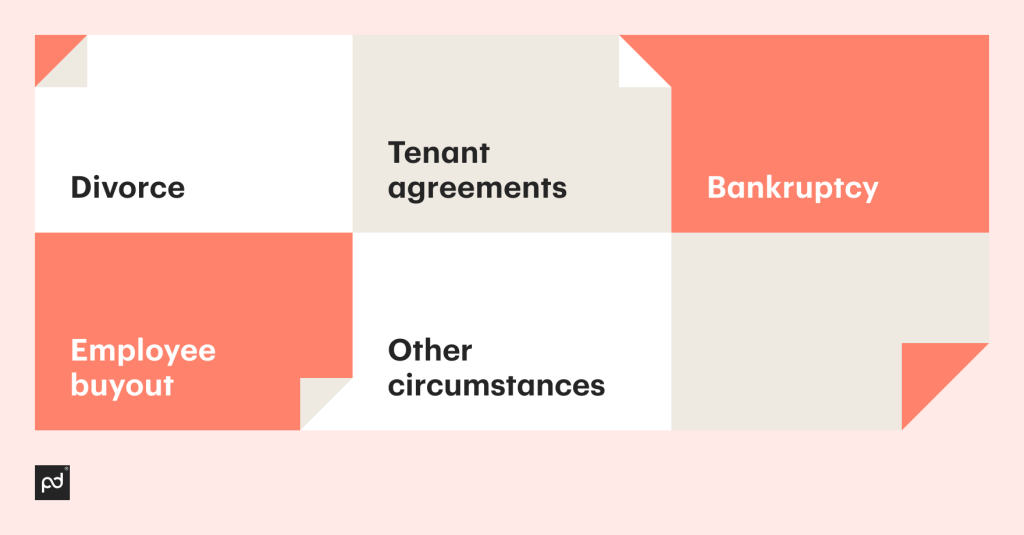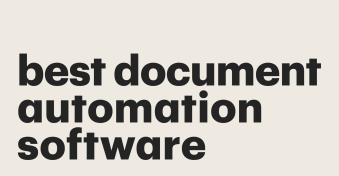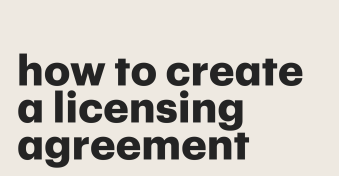Every business partnership has a chance of ending due to unforeseen circumstances, differences in opinion, personality clashes, or financial issues.
Regardless of the reason, one party can always relieve the other of all responsibility using a buyout agreement.
If done wrong, buying another person out could turn into an acrimonious process that drowns you in legal fees and paperwork.
So you need to understand what buyout agreements entail and how to use them to break cleanly from any partnership.
We’ll discuss everything worth knowing about buyout agreements for businesses and individuals.
Continue reading to find out how a buyout agreement works, as well as its key components.
Key takeaways
- A buyout agreement outlines how one partner can purchase the leaving partner’s shares in the collectively owned business.
- Buyout agreements also contain succession plans in cases where one of the partners has specific instructions and restrictions regarding ownership.
- Depending on the purpose, buyout agreements are also called entity-purchase agreements, cross-purchase agreements, or wait-and-see agreements.
- You can use a buyout agreement when settling a divorce, ending a tenant agreement, or when one partner is temporarily or permanently incapacitated.
What is a buyout agreement?
A buyout agreement (buy-sell agreement) is a contract between two business partners to end their cooperation.
This agreement makes provisions for voluntary and involuntary departure of one side of a partnership.
Examples of buyout agreements
Buyout agreements can vary in purpose or definition:
- A cross-purchase agreement allows the remaining partner(s) to purchase the deceased or departing owner’s interest.
- A redemption (entity-purchase) agreement allows the business itself to buy the shares of the departing partner.
- A wait-and-see agreement combines elements of both the cross-purchase and redemption agreement. In case of a potential buyout, the remaining partners buy some shares while the company retains the rest.
How does a buyout agreement work?
The terms of the operating agreement contain a buyout clause — a provision outlining each partner’s shares and how to distribute them.
The buyout clause also mentions withdrawal events, payment terms, and eligible buyers.
Once a partner or third party triggers the buyout clause, the remaining partners must accept the agreement and start processing the payments for the ownership interest according to business law and the agreed-upon timeline.
If the partners don’t have a buyout agreement — or one party refuses to honor the terms of the agreement — they might end up in a protracted legal battle, which often leads to one person feeling aggrieved.
In some cases, the state might dissolve the partnership whether it is a PLC (public limited company) or LLC (limited liability company).
What should be included in a buyout agreement?
A well-crafted buyout agreement should contain the following:
- A recent valuation of business assets and interests
- A comprehensive list of business partners or owners and their contact information
- Non-compete clauses and confidentiality agreements
- Dispute resolution mechanisms
- Payment terms and funding instruments
- Estate planning for the surviving beneficiaries
The common trigger for buyouts is the intended departure of one of the partners.
But sometimes, a third party can trigger the buyout clause by declaring interest in the business or asset.
They can also fund the buyout with a loan, an insurance policy, recurring revenue, or upfront capital.
Use cases for buyout agreements
The governing law for buyouts differs by industry and geographic location.
Let’s explore some common examples and applications of buy-sell agreements.

Divorce
When a couple ends their marriage, one could decide to buy out the other’s interests in the business.
If they are both co-owners, one of them should make an official buyout offer.
The provisions of the split might be in their prenup or the partnership agreement.
If not, the court will have to step in to enforce how the distribution or sharing of assets occurs.
Tenant agreements
According to real estate law in the City of Santa Monica, landlords can buy out tenants if they want them to vacate a rental unit voluntarily.
This tenant buyout is under the jurisdiction of the Rent Control Board.
In New York City, the NYC Housing Preservation and Development handles buyouts between owners and renters.
Suppose the landlord doesn’t disclose their intention to buy out the tenant within the specified deadline, as well as that tenant’s right to rescind consent within 45 days.
In that case, the tenant can sue the landlord to the city council for violation of tenant rights.
Bankruptcy
When a partner goes bankrupt, they can sell their shares in the company to service the debt instead of putting the business in financial trouble.
Let’s say you own a T-shirt startup, but your co-owner can no longer fund their end of the deal due to outstanding debt.
You or an approved third party can offer to buy them out.
In corporate settings, this could become an acquisition just like how Blackstone Group purchased Hilton Hotels in 2007 in order to relieve the hotel chain of its debt.
Employee buyout
French soccer club PSG acquired Neymar from Barcelona by triggering his buyout clause.
Neymar’s contract with Barcelona allowed him to leave if any other club (a third party) was willing to pay $230 million.
Once PSG made the offer, Barcelona had no legal right to reject it.
Also, businesses can buy out employee contracts when they want to lay them off.
For example, Elon Musk can get rid of top engineers and managers at Twitter by offering to buy their equity.
In exchange, the employees should get a healthy severance package — or Musk will face a multimillion dollar lawsuit.
Other circumstances
Buyout agreements establish a financial plan for managing every partner’s assets in case of death, pandemic, incapacitation, or disability.
Also, the retirement of one partner or ex-spouse can trigger the buyout scenario.
Follow these steps when issuing or signing buyout agreements
Before drafting or signing a buyout agreement, you must follow a systematic approach to protect your interests and keep everything above board.
Here are the steps to follow:
1. Understand the legal requirements
First, learn the federal and state regulations about different types of buyout agreements.
Consulting relevant authorities will help you draft a buy-sell contract that complies with local, national, and international law (for multinational companies).
Hire a law firm or business attorney to review and draft the agreement to ensure it is legally binding and compliant.
2. Align the agreement with your business/personal goals
Ensure the buyout agreement doesn’t leave you in a position of being disadvantaged.
Say you want to leave a company due to sickness — you need a buyout agreement that guarantees maximum proceeds from selling your assets.
At the same time, you also need to establish a succession plan to prevent the company from falling into the hands of business owners who don’t care about its core values.
If possible, outline every key participant and their core responsibilities.
3. Know the potential risks
One risk involved in triggering a buyout is that the company’s market value might drop.
For example, when Steve Jobs died, Apple’s stock dropped significantly.
So, when a majority owner or co-founder wants to be bought out, this could affect the company’s ability to follow through with agreed payments due to limited available funds.
Another potential risk is that your departure might provide a financial and administrative vacuum your partner won’t be able to fill.
This often leads to your business falling into the hands of the wrong people.
4. Send your partners a notice
Some buyout scenarios require prior notice to the partner, while others don’t — death and incapacitation fall within this bracket.
Under San Francisco law, every landlord must file a pre-buyout disclosure (at least 30 days before discussions) with the tenant and then to the Rent Control Board 14 days later.
The same procedure applies to leaving a partnership or LLC.
You need to notify other partners and shareholders in advance so they can arrange their affairs and start working on a succession plan.
5. Draft the agreement
Once every partner agrees, put everything in writing as a legal document.
The legal team usually takes over from here, especially in massive corporations with lots of moving parts.
But small business partnerships can use a buyout agreement template.
They can also use online document repositories to create a consolidated paper trail for easy access and tracking.
6. Negotiate terms
During buyout negotiations, other partners will try to get the best deal for their money.
This process could drag on through multiple iterations and redlining to get a favorable outcome for all participants.
Some issues to discuss during negotiations include the new ownership hierarchy, transfer restrictions, minority interests, trigger events, and estate planning.
Instead of shuffling paper between offices, all partners can monitor the entire negotiation process using a document management platform.
Doing so will guarantee transparency and hasten the buyout process.
The money talk is also part of the negotiation because it is the crux of every buyout agreement.
The payment structure negotiations should cover the buyout price, funding methods, and timelines.
Some key considerations include:
- The current market trends and business outlook
- The business’s historical performance and track record
- The available financial assets
- Tax implications for the departee and remaining partners
- The company’s earning capacity and net profitability
- Potential buyer restrictions or sales embargoes
- Payment amount, schedule, and method
7. Sign the agreement
After the back and forth with other partners, seek legal advice from a lawyer to review the final draft of the buyout agreement to ensure every provision is legal and fair.
After that, you can sign the agreement.
8. Execute the agreement
For immediate buyouts, you can start working on ending the partnership.
Otherwise, wait for the trigger event to execute the buyout agreement.
If the other party declines to honor the terms of the legally binding agreement, lawyer up and sue them.
Why do you need a buyout agreement?
Buy-sell agreements can protect each partner’s interests, provide for their estate, and keep their business out of undesirable hands. Here is how.
Leave whenever you want
If the business is taking an approach that goes against your moral compass — say an open source company (OpenAI) now wants to close their algorithm and charge people for access — you can trigger the buyout clause without being held hostage.
Keep the courts away from your business
Without a buyout agreement, most disputes within partnerships end up going to court.
Sometimes the court, by law, can confiscate assets until both parties reach a resolution.
Remove undesirable owners
Suppose one of the business partners is involved in a scandal that could ruin the company’s reputation.
The other partners can offer to buy them out, washing their hands off the ousted partner’s indiscretions.
Protect intellectual property
Buyout agreements usually contain non-competes, which guarantees that the leaving partner will not use insider information to work against the company’s interests.
For instance, Twitter (X) employees cannot join Meta (Threads) until the non-compete period elapses.
Draft and sign your buyout agreements with PandaDoc
A buyout agreement allows you to end partnerships amicably.
It helps partners set up a smooth transfer of assets and responsibilities without resorting to legal action.
Buyout agreements also provide a payment structure as well as a contingency plan to compensate the leaving partner and prevent them from upstaging the business from outside.
If you are looking for a fast way to draft buyout agreements, PandaDoc has ready-made templates.
You can use this document management solution for every stage of drafting, negotiating, and editing your buyout agreement.
You can also use our robust e-signature solution to add legally binding signatures and stamps to your buyout contracts.
Learn more about the PandaDoc platform by scheduling a free demo.
Frequently asked questions
-
The buyout agreement should include the terms of departure, the payment structure, and the succession plan. It should also contain non-compete and non-disclosure clauses, as well as potential risks and penalties.
-
Yes, a buyout agreement is legally binding if it follows all applicable local or federal regulations as well as meets the terms agreed upon by all involved partners. And once all partners sign it, the contents become binding by law.
-
If one party disregards the buyout agreement, they could be liable to lawsuits, fines, and other penalties. If the court mandates their acceptance, and they refuse, they’d be in contempt of court and in danger of potential jail time or heftier fines.
-
To buy out a partner, you have to notify them or wait for a trigger event mentioned in the buyout agreement to occur. Afterward, you’ll need to discuss the fine details of the separation and the buyout amount. Once everything is agreed upon, you can buy them out and retain sole business ownership.
Disclaimer
PandaDoc is not a law firm, or a substitute for an attorney or law firm. This page is not intended to and does not provide legal advice. Should you have legal questions on the validity of e-signatures or digital signatures and the enforceability thereof, please consult with an attorney or law firm. Use of PandaDocs services are governed by our Terms of Use and Privacy Policy.


